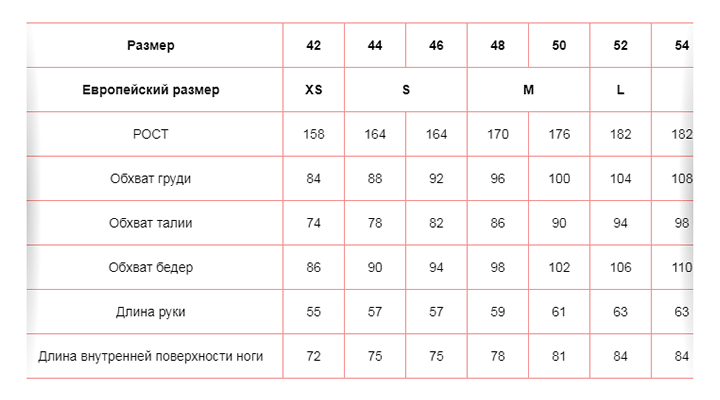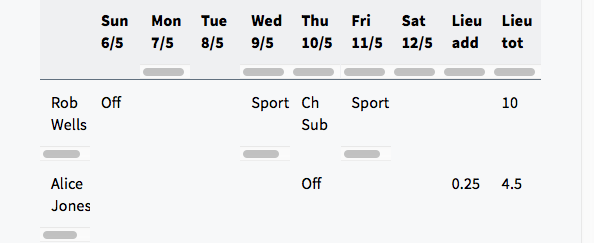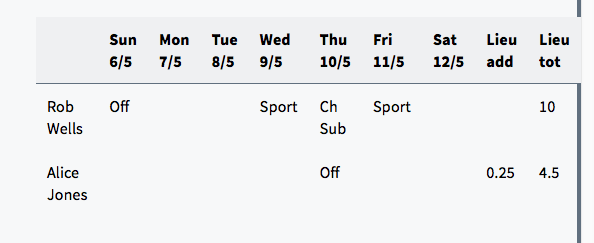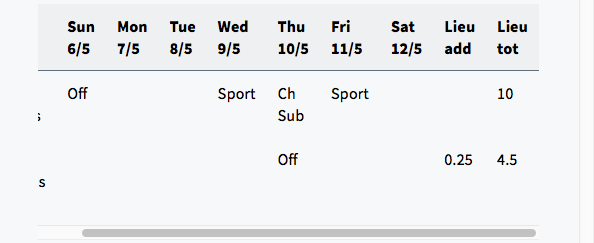Как сделать горизонтальную прокрутку таблицы на сайте
Бывает, что при создании мобильной версии сайта, нужно сделать так, чтобы таблица была хорошо видна, но при этом она настолько большая, что ее не уменьшить до размеров экрана мобильного устройства так, чтобы было нормально видно все ее ячейки.
В этом случае выручит горизонтальная прокрутка таблицы, так будет намного лучше видно ее содержимое.
Сделать горизонтальную прокрутку таблицы очень просто, достаточно знать алгоритм работы такой верстки, ну а написать стили, это уже совсем просто.
Настройка
Для того, чтобы у таблицы появилась горизонтальная прокрутка, ей нужно задать фиксированную ширину и поместить внутри родительского блока, у которого ширина будет изменяться.
Создаем родительский блок с классом table-wrap , задаем ему максимальную ширину равную ширине таблицы, простую ширину делаем 100%, атрибут overflow ставим в auto.
Затем внутри него создаем таблицу с классом table и фиксированной шириной.
Вид услуги Ед. изм. Цена (руб.) Кол-во посещений Консультация психолога Посещение от 2000 руб. 1 Консультация гастроэнтеролога Посещение от 5000 руб. 1
| Вид услуги | Ед. изм. | Цена (руб.) | Кол-во посещений |
|---|---|---|---|
| Консультация психолога | Посещение | от 2000 руб. | 1 |
| Консультация гастроэнтеролога | Посещение | от 5000 руб. | 1 |
При ширине страницы 1000px и более прокрутки видно не будет, при уменьшении размера страницы по ширине, у таблицы появится горизонтальная прокрутка.
Настройка внешнего вида таблицы создается с помощью дополнительных стилей.
Как видите все просто, используйте этот способ в своих работах и создавайте качественный контент.
Как вместить большие таблицы на страницы сайта
Обычно на мобильных скролбар скрыт и не совсем понятно что есть возможность прокрутить таблицу. Более лучший вариант можно сделать добавлением теней по бокам таблицы.
.big-table < overflow: auto; position: relative; >.big-table table < display: inline-block; vertical-align: top; max-width: 100%; overflow-x: auto; white-space: nowrap; -webkit-overflow-scrolling: touch; >.scroll-right:after < content: ''; display: block; width: 15px; position: absolute; top: 0; right: 0; bottom: 0; z-index: 500; background: radial-gradient(ellipse at right, rgba(0, 0, 0, 0.2) 0%, rgba(0, 0, 0, 0) 75%) 100% center; background-repeat: no-repeat; background-attachment: scroll; background-size: 15px 100%; background-position: 100% 0%; >.scroll-left:before
JQuery:
$(function() < $('table').wrap('box_width) < $(this).addClass('scroll-right'); >else < $(this).removeClass('scroll-right'); >>); > resize_table_box(); $( window ).on('resize', function() < resize_table_box(); >); $('.big-table table').on('scroll', function() < var parent = $(this).parent(); if ($(this).scrollLeft() + $(this).innerWidth() >= $(this)[0].scrollWidth) < if (parent.hasClass('scroll-right') )< parent.removeClass('scroll-right'); >> else if ($(this).scrollLeft() === 0) < if (parent.hasClass('scroll-left'))< parent.removeClass('scroll-left'); >> else < if(!parent.hasClass('scroll-right'))< parent.addClass('scroll-right'); >if(!parent.hasClass('scroll-left')) < parent.addClass('scroll-left'); >> >); >);Результат:
Комментарии 2
Привет мастер! Совершенно случайно попал на эту страничку и обнаружил на ней скрипт моей мечты – очень давно хотел, чтобы таблица имела что-то позволяющее понять, что есть горизонтальная прокрутка таблицы. Попробовал применить ваш замечательный Код, однако столкнулся с проблемой. Если вся конструкция расположена непосредственно на странице со статьёй, то всё работает, но стоит вынести JS во внешний файл (на моём сайте много страниц с большими таблицами), перестаёт работать эффект тени. Как-то можно побороть эту неприятность?
Ничего не понимаю, почему это не работает здесь? https://re-news.com.ua/news/klassifikaczii-novostroek-kakie-byvayut-i-chem-otlichayutsya-2/
Авторизуйтесь, чтобы добавить комментарий.
Другие публикации
Обойти ячейки таблицы можно с помощью jQuery метода each, например следующий код выводит текст из всех ячеек в консоль.
Making Tables Scrollable in CSS
Because HTML tables are set to display: table by default, adding scrollbars to them is a bit nonintuitive.
We can set our tables to display: block and modify their overflow from there, but I’ve found wrapping tables in containers to be more adaptable and flexible.
Link to this section
Vertical table scrollbars
First, let’s set up vertical scrolling.
div class="tableContainer"> table class="table"> . table> div> We can set a height for the table’s container and modify the table such that it will fit snug within the container:
.tableContainer < height: 300px; overflow: hidden; > .table < position: sticky; top: 0; width: 100%; > In this example, I set the height to 300px — but you can set it to whatever you want!
Our table will now have an inset vertical scrollbar and will expand no further than the height we set.
Link to this section
Horizontal table scrollbars
If you want to implement horizontal scrolling, there is an approach very similar to the vertical scrolling example:
.tableContainer < overflow: hidden; width: 800px; > .table < position: sticky; top: 0; width: 100%; > I set the width here to 800px , but again, you can change it to whatever you want.
If you want both horizontal and vertical scrollbars for your table, simply specify both a height and a width in .tableContainer .
Link to this section
And that’s how you can make your tables scrollable with just a bit of CSS!
I refer back to this snippet all the time, and I hope you found it useful too.
Primary Unit
After I published my post about manipulating tables (of data) in R, I noticed that there was something amiss with the HTML table in that post showing an example section of our newsroom rota.
When I first wrote the CSS for this site, roughly five years ago, I had HTML tables set so that the whole table would scroll were it to be too wide for its containing column. At least, I’m pretty sure it worked like that.
Anyway, as you can see above, it doesn’t work like that now. The table there is laid out with the following CSS:
Which has the effect of restricting the table size to 100%, and doing odd things to the cells if there’s too much to fit in whatever width 100% happens to be.
As an attempted quick fix, I removed the table-layout property so that it would inherit the default, auto . The width is still 100% to provide some consistency, rather than having an odd assortment of table widths.
This has the effect of having the table overflow the container horizontally if the content is too wide, like so:
Which is perhaps more readable if pretty ugly. And not what I wanted: to scroll the entire table within its container.
I said attempted earlier because I, er, never deployed the change on the site (it’s been a busy couple of weeks, contrary to the post tempo).
In the meantime, I stumbled across a fix by opening Safari’s reader mode, in which tables scroll horizontally within their container! The secret? The table is wrapped in an enclosing div , which has its overflow-x property set to auto , and then the table scrolls within the div.
Here’s what that looks like when rendered:
You want auto instead of scroll as the latter shows the scrollbar all the time.
Primary Unit
After I published my post about manipulating tables (of data) in R, I noticed that there was something amiss with the HTML table in that post showing an example section of our newsroom rota.
When I first wrote the CSS for this site, roughly five years ago, I had HTML tables set so that the whole table would scroll were it to be too wide for its containing column. At least, I’m pretty sure it worked like that.
Anyway, as you can see above, it doesn’t work like that now. The table there is laid out with the following CSS:
Which has the effect of restricting the table size to 100%, and doing odd things to the cells if there’s too much to fit in whatever width 100% happens to be.
As an attempted quick fix, I removed the table-layout property so that it would inherit the default, auto . The width is still 100% to provide some consistency, rather than having an odd assortment of table widths.
This has the effect of having the table overflow the container horizontally if the content is too wide, like so:
Which is perhaps more readable if pretty ugly. And not what I wanted: to scroll the entire table within its container.
I said attempted earlier because I, er, never deployed the change on the site (it’s been a busy couple of weeks, contrary to the post tempo).
In the meantime, I stumbled across a fix by opening Safari’s reader mode, in which tables scroll horizontally within their container! The secret? The table is wrapped in an enclosing div , which has its overflow-x property set to auto , and then the table scrolls within the div.
Here’s what that looks like when rendered:
You want auto instead of scroll as the latter shows the scrollbar all the time.



